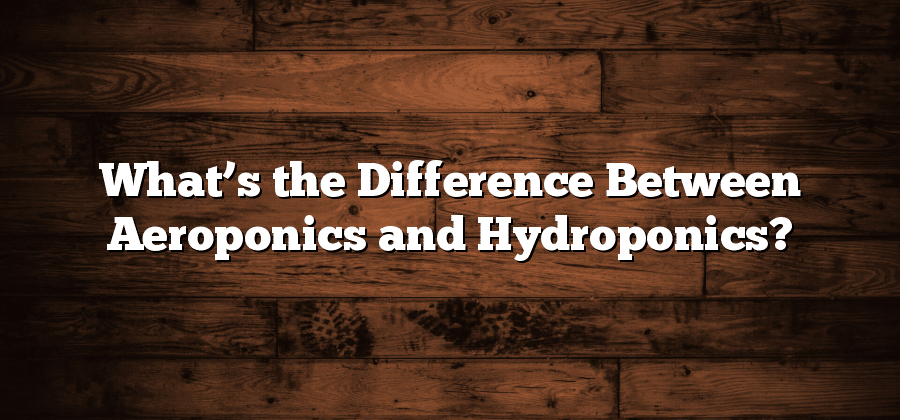Aeroponics: The Basics
Aeroponics is a cutting-edge method of growing plants that is gaining popularity among horticulturists and indoor gardeners. Unlike traditional soil-based cultivation or hydroponics, aeroponics involves suspending plant roots in air and misting them with a nutrient-rich solution. This allows for maximum oxygenation and nutrient absorption, promoting faster growth and higher yields.
One of the key advantages of aeroponics is its efficiency in water usage. By misting the plant roots at regular intervals, the water is directly absorbed by the plants, leaving no room for wastage or evaporation. This makes aeroponics a highly sustainable option for those looking to conserve water and reduce their environmental footprint. Additionally, the absence of soil in aeroponic systems eliminates any concerns related to soil-borne diseases or pests, making it ideal for sterile and controlled environments.
Hydroponics: The Basics
Hydroponics is a modern method of growing plants without the use of soil. Instead, plants are grown in a nutrient-rich water solution, allowing for quicker and more efficient growth. This technique has gained popularity in recent years due to its numerous advantages.
One of the key benefits of hydroponics is its ability to save water. Unlike traditional soil-based agriculture, hydroponics recycles water, reducing water usage by up to 90%. This makes it an environmentally friendly option, especially in areas where water scarcity is a concern. Additionally, the controlled environment of hydroponic systems allows for more precise control over nutrient delivery and pH levels, resulting in healthier and more productive plants. With hydroponics, growers also have the flexibility to cultivate plants year-round, regardless of climate or season, making it an attractive option for those looking to optimize their agricultural output.
In conclusion, hydroponics provides a sustainable and efficient alternative to traditional soil-based farming. Its water-saving capabilities, precise nutrient delivery, and ability to overcome climate limitations make it an ideal choice for modern farmers. By harnessing the power of hydroponics, we can meet the increasing demands for food production while minimizing our impact on the environment.
Growing Medium: Aeroponics vs Hydroponics
A crucial factor to consider when comparing aeroponics and hydroponics is the choice of growing medium. In aeroponics, plants are grown without any medium, as their roots are suspended in air and misted with nutrient-rich water. This method allows for maximum oxygenation and nutrient uptake, promoting healthier and faster plant growth. Hydroponics, on the other hand, relies on a solid medium such as perlite, coconut coir, or rockwool to support plant roots. These mediums provide stability, aeration, and moisture retention, ensuring the plants have a consistent source of water and nutrients.
The choice of growing medium in both aeroponics and hydroponics ultimately depends on various factors, such as the specific plants being grown, availability, and personal preference. While aeroponics offers the advantage of eliminating the need for a solid medium, hydroponics provides a more traditional approach, resembling soil gardening in some ways. Understanding the pros and cons of each method can help cultivators make an informed decision about which growing medium will best suit their needs and goals for successful crop production.
Watering Technique: Aeroponics vs Hydroponics
Aeroponics and hydroponics are two popular methods of growing plants without soil. While both methods provide controlled environments for optimal plant growth, they differ in their watering techniques. Aeroponics utilizes a misting system to deliver water and nutrients to the plant roots, while hydroponics involves submerging the roots in a nutrient-rich solution.
In aeroponics, plants are suspended in air with their roots exposed. A misting system is employed to spray a nutrient solution directly onto the roots. This method allows for increased oxygenation of the roots and promotes faster growth and nutrient absorption. The misting system can be automated, ensuring a consistent supply of water and nutrients to the plants. Additionally, aeroponics requires less water compared to hydroponics, making it a more sustainable option. However, the misting system may require regular maintenance to prevent clogging and ensure proper functioning.
Nutrient Delivery: Aeroponics vs Hydroponics
Aeroponics and hydroponics are two popular methods of growing plants without soil. While both systems provide plants with the necessary nutrients for growth, they differ in terms of nutrient delivery. In aeroponics, the plants are suspended in air or a misted environment, with the nutrient solution delivered directly to the roots through a fine mist or spray. This method ensures that the plants receive a high concentration of nutrients and oxygen, promoting rapid and efficient growth.
On the other hand, hydroponics involves growing plants in a water-based solution containing dissolved nutrients. The nutrient solution is continuously circulated or periodically flushed through the root system, providing the plants with a constant supply of essential elements. This method allows for precise control over the nutrient levels and pH of the solution, ensuring optimal conditions for plant growth.
While both aeroponics and hydroponics excel in delivering nutrients directly to the plants, each method has its own advantages and considerations. The choice between the two ultimately depends on factors such as the type of plants being grown, available resources, and specific growing goals. By carefully evaluating these factors, growers can determine which nutrient delivery system best suits their needs and maximizes the potential for plant success.






